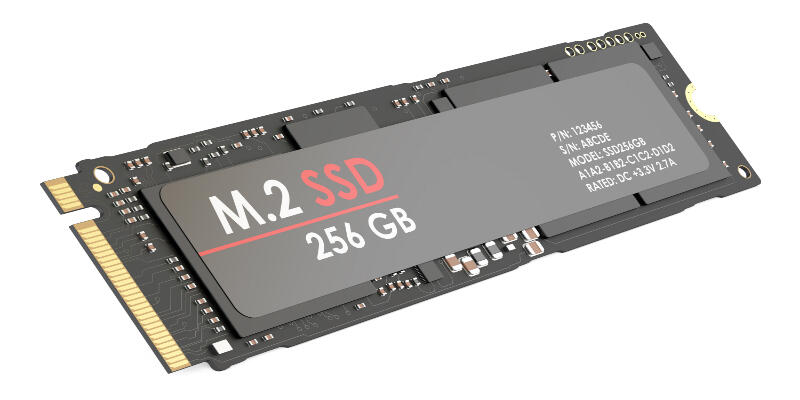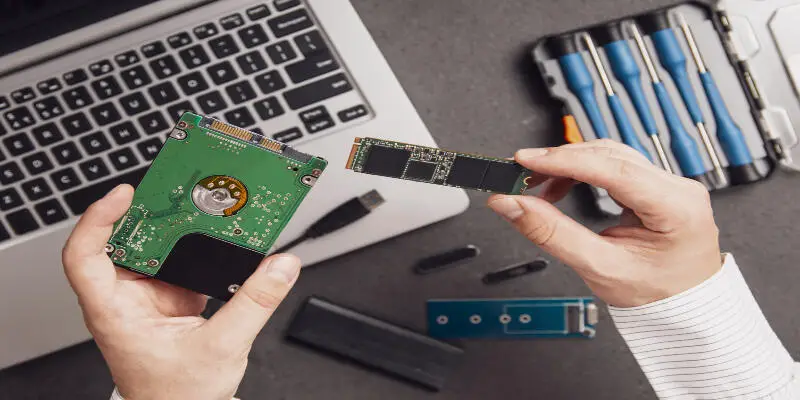Disclaimer: This post may contain affiliate links, meaning we get a small commission if you make a purchase through our links, at no cost to you. For more information, please visit our Disclaimer Page.
An M2 SSD Card is smaller than its predecessors. You can mistake it for RAM at first glance due to its size. However, these portable drivers are known to be more expensive than the original 2.5-inch SSD. It might be small, but it can do greater things than the heavy hard drive, such as faster performance.
Because of its small size, the M.2 SSD requires cooling since it uses a lot of power due to its high-performance features. Because of this, a heatsink is often required when operating the M.2 SSD card.
Therefore, a M.2 card is more sensitive. We will explain why M.2 SSDs overheat quickly, as well as the best tips for taking care of them. For sure you will also become more attentive to your computer once you learn how to cool your M.2 SSD.
After all, permanent damage is what I always want to avoid when teaching how to maintain a computer.
Table of Contents
Does A M.2 SSD Need Cooling?
The body of an M.2 SSD is almost as small as RAM. It powers up at a higher rate than SSDs despite the similarity to the build and internal parts of the two devices.
Since a M.2 SSD is smaller than its predecessor and small, heat is easily distributed throughout the device as it works for hours. This quickly causes the card to overheat faster than hard drives.
When one of our colleagues first bought an M.2 SSD as an upgrade to my old SSD, he almost got the device damaged after a week of using it without reconsidering the setup of the unit’s airflow.
We noticed the lack of cooling when my M.2 SSD suddenly slowed down more than a week after neglecting it.
Because of this, we researched thoroughly until we could prevent the damage and make my computer’s airflow more optimized. Today, we will share everything we learned from that harsh lesson that we realized when handling this sensitive device.
Can M.2 SSD Overheat?
The M.2 SSD is known to overheat easily. Some even say it can overheat faster than the classic hard drive if the enclosure lacks proper airflow. Some may say that different factors cause this device to easily overheat.
To make it easier for you to understand, we enumerated the reasons why the M.2 SSD overheats. The following reasons are all based on our experience and what people I know shared with me when they had an issue setting up their own M.2 SSD.
Here are the different reasons an M.2 SSD overheats, as well as ways to resolve the issues:
Hot Room Temperature
Operating a computer that is an M.2 SSD is dangerous, especially those with high-performance devices if it is inside a room with hot temperature or poor ventilation.
It is a well-known fact that computers should be set up in a room with cool temperature, or at least good airflow.
It is also not wise to place your computer in a narrow space just because you have a good airflow inside your unit.
Using fans is an excellent choice, but installing an air conditioning system inside your room is what most usually recommend. In that way, the M.2 SSD’s temperature will always become stable, preventing permanent damage.
A Dirty Enclosure
As much as possible, avoid any dirt and dust from building up inside the enclosure of your computer. If you’re using a laptop, consider cleaning the sides to prevent the M.2 SSD to heat up.
Never neglect any dust or dirt in your unit because it might get stuck in some of your computer parts, which can also cause further damage.
Your M.2 SSD will easily overheat if there is too much dirt and dust buildup, particularly along with the fans or heatsink of your computer.
Other junk that might have gotten inside the enclosure should be removed since dirt, dust and any obstruction can disrupt the airflow, preventing heat from getting trapped in the enclosure.
You mustclean the whole unit twice a year to prevent dust and dirt buildup. Check the fans for signs of dust building up at least once a month to ensure excellent cleanliness to your computer.
Treat your computer like a pet that you invested a lot of money to keep it from getting sick.
Bad M.2 SSD Card Position
This is the harsh lesson we discussed when we noticed that the colleague’s M.2 SSD was heating up quickly after a week of using it for several hours each day. He did not notice it until 7 days after he got the M2 SSD when it started booting by files really slow.
The position of your M.2 SSD might be the root cause of the overheating issue. This is what commonly happens even if you are fully aware that you have properly installed everything to cool your unit.
Note that the position has nothing to do with the airflow; the nearby devices are what you should be careful of.
The CPU and GPU are the top devices that generate the most heat when the computer operates. That is why exhaust fans are built or must be installed around them to stabilize their temperature.
If your M.2 SSD card happens to be positioned near these devices, expect the card to overheat faster even if fans are installed near it.
If this is the case in your unit, it’s best to reposition some of your computer parts. As much as possible, distance the card away from the GPU and the CPU so the heat won’t get distributed around the casing of the M.2 SSD.
The card itself already generates heat due to its power to give you faster loading time.
It is best to understand the following main causes how your M.2 SSD might overheat. This time, you will learn the importance of installing a heatsink if you wish to maintain your M.2 SSD for a long time.
Do I Need Heatsink For M.2 SSD?
Since M.2 SSDs are too prone to overheat, a heatsink should be purchased along with the card. Expect that you will spend a lot on both devices.
But rest assure, your investment will all be worth it if you wish to maximize the performance of your computer.
A heatsink works exactly like its kitchen versions. But instead of water, it filters out the heat away from the hottest computer parts running inside your enclosure.
Couple this with an exhaust fan, and you will never have to deal with sudden replacements ever again.
The steps to set up the heatsink vary by make and model. It is also best to seek expert opinion in handling this delicate equipment. But as far as experience goes, here are some basic steps to get you started:
- Apply thermal compound to your CPU.
- Use the holes on your motherboard to correctly align the fan and the heatsink.
- At this point, you can consider changing the position of your M.2 SSD if you want it to get the most out of the cooling capabilities of your heatsink.
- Install the combined fan and heatsink to the CPU, be sure to install them tightly.
- Connect the equipment to your CPU to get started.
- Check if the CPU is securely plugged into the motherboard’s socket. Once done, apply the thermal paste and test out your heatsink.
Note: Do not forget to thoroughly read the manufacturer’s manual if you need to learn more about the proper set up of your heatsink once you receive it.
The steps we gave you are the basics of handling a heatsink during installation. These are all based on the common steps when installing a heatsink in computers.
The actual steps of the heatsink you purchased might differ depending on the manual’s contents.
Note that any error in setting up the heatsink can cause damage to your computer, which will cost you even more than just your M.2 SSD.
How Do I Cool Down M.2 SSD?
Aside from using the heatsink to cool down your M.2 SSD, here are some tips that I often teach to my clients when setting up their units:
The Alternative To The Expensive HeatSink
If you cannot afford a heatsink in the meantime, you can use the classic way of maximizing the airflow of your enclosure. All you need are more than 2 exhaust fans to get started.
You may install the fans near your M.2 SSD to completely blow away the heat produced by the card.
Ensure you regularly check the fans weekly for any dust buildup to prevent the heat from getting trapped. Also, do not settle for the cheaper fans that might get bused after a few months, causing you to do needless replacements.
Room And Computer Setup, The Right Way
You are using an M.2 SSD already, meaning you should never settle for cheap parts that may affect its performance. Even so, look for the most cost-efficient prices to save a few bucks.
I often save more than a hundred dollars simply by comparing prices in the market by store, device make, and model.
Once you have the right equipment, install each part properly. When installing the M.2 SSD, put it away from the devices that produce the most heat.
Since the card easily heats up, it should be placed in a well-ventilated area of your unit’s enclosure.
Lastly, you should consider a room with a cool temperature. Apply an air conditioning system when needed, or if you are going to operate a group of computers with the M.2 SSD installed.
What Are The Benefits Of A Cool M.2 SSD?
The M.2 SSD compared to its predecessors if you keep it cool:
Saves You A Great Deal Of Money
Since M.2 SSD cards cost a lot; preventing them from getting damaged because of overheating can save you hundreds of dollars.
If you also have business files in your SSD, then that means you can save a greater deal of money because you get to protect them from harm.
Faster Performance
The M.2 SSD is already known to perform very fast. But to keep its speed consistent, you need to maintain it and prevent it from heating properly.
Much like the CPU, it also shuts off a part of it to slow down its performance, which prevents it from heating further once the temperature rises.
Conclusion
The M.2 SSD is the hardest to cool compared to its predecessors. It is also the most expensive to cool because the heatsink is often required when using this card. But expect high performance on your computer once you follow all these tips!


